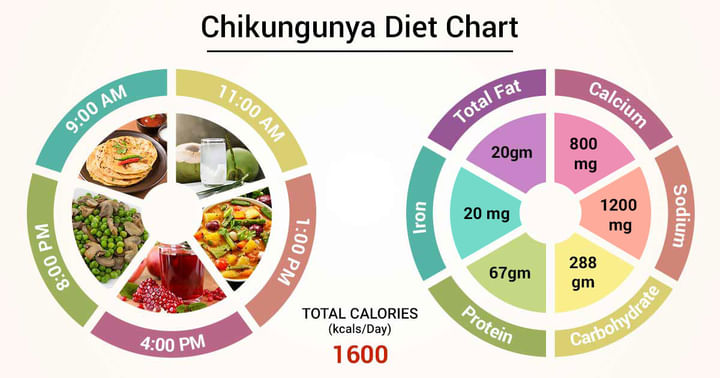Diet Chart For Chikungunya
Last Updated: Jan 20, 2025
About
Chikungunya is an infection caused by the chikungunya virus (CHIKV). Symptoms include fever and joint pain. These typically occur two to twelve days after exposure. Other symptoms may include headache, muscle pain, joint swelling, and a rash. Most people are better within a week; however, occasionally the joint pain may last for months. The risk of death is around 1 in 1,000. The very young, old, and those with other health problems are at risk of more severe disease.
The virus is spread between people by two types of mosquitos: Aedes albopictus and Aedes aegypti. They mainly bite during the day. The virus may circulate within a number of animals including birds and rodents. Diagnosis is by either testing the blood for the virus's RNA or antibodies to the virus. The symptoms can be mistaken for those of dengue fever and Zika fever. After a single infection it is believed most people become immune. The best means of prevention is overall mosquito control and the avoidance of bites in areas where the disease is common. This may be partly achieved by decreasing mosquitoes' access to water and with the use of insect repellent and mosquito nets. There is no vaccine and no specific treatment as of 2016. Recommendations include rest, fluids, and medications to help with fever and joint pain.
Diet Chart
| Sunday | |
| Breakfast (8:00-8:30AM) | 2 potato parantha + 1 cup yogurt |
| Mid-Meal (11:00-11:30AM) | 1 cup coconut water |
| Lunch (2:00-2:30PM) | 1 cup green gram dal + 1 cup mix vegetable + 2 chapati + salad |
| Evening (4:00-4:30PM) | 1 cup pomegranate juice + 2 toatsed bread |
| Dinner (8:00-8:30PM) | 1 cup peas mushroom vegetable + 2 chapati + salad |
| Monday | |
| Breakfast (8:00-8:30AM) | 1 cup vegetable upma + 1 cup mausambi juice |
| Mid-Meal (11:00-11:30AM) | 1 cup buttermlk |
| Lunch (2:00-2:30PM) | 1 cup kidney beans + 1 cup calocasia + 2 chapatti + 1/2 cup yogurt + salad |
| Evening (4:00-4:30PM) | 1 cheese sandwich + 1 cup vegetable soup |
| Dinner (8:00-8:30PM) | 1 cup cabbage and potato vegetable + 2 chapatti + salad |
| Tuesday | |
| Breakfast (8:00-8:30AM) | 2 besan cheela + green chutney + 1 cup light tea |
| Mid-Meal (11:00-11:30AM) | 1 cup pomegranate juice |
| Lunch (2:00-2:30PM) | 1 cup masoor dal + 1 cup potato pea vegetable + 2 chapatti + 1/2 cup yogurt + salad |
| Evening (4:00-4:30PM) | 1 cup vegetable vermicilli + 1 cup light tea |
| Dinner (8:00-8:30PM) | 1 cup bottlegourd + 2 chapatti + salad |
| Wednesday | |
| Breakfast (8:00-8:30AM) | 2 vegetable suji upma + corriander and tomato chutney + 1 cup orange juice |
| Mid-Meal (11:00-11:30AM) | 1 cup coconut water |
| Lunch (2:00-2:30PM) | 1 cup chana dal + 1 cup parwal vegetable + 2 chapatti + 1/2 cup yogurt + salad |
| Evening (4:00-4:30PM) | 1 cup sabudana khichdi + lichi juice |
| Dinner (8:00-8:30PM) | 1 cup bittergourd + 2 chapatti + salad |
| Thursday | |
| Breakfast (8:00-8:30AM) | 1 potato sandwich (using 3 bread slices) + 1 cup orange juice |
| Mid-Meal (11:00-11:30AM) | 1 cup buttermilk |
| Lunch (2:00-2:30PM) | 1 cup moong dal + 1 cup beans + 2 chapatti + 1/2 cup yogurt + salad |
| Evening (4:00-4:30PM) | 1 cup vegetable poha + 1 cup coconut water |
| Dinner (8:00-8:30PM) | 1 cup cottage cheese and capsicum vegetable + 2 chapatti + salad |
| Friday | |
| Breakfast (8:00-8:30AM) | 2 bread pizza + green chutney + 1 cup mix fruit juice |
| Mid-Meal (11:00-11:30AM) | 1 cup pomegranate juice |
| Lunch (2:00-2:30PM) | 1 cup mix dal + 1 cup ridgourd vegetable + 2 chapatti + 1/2 cup yogurt + salad |
| Evening (4:00-4:30PM) | 1 carrot and beetroon juice + 1 cup poha |
| Dinner (8:00-8:30PM) | 1 cup beans vegetable + 2 chapatti + salad |
| Saturday | |
| Breakfast (8:00-8:30AM) | 2 black chana parantha + 1 cup yogurt |
| Mid-Meal (11:00-11:30AM) | 1 cup coconut water |
| Lunch (2:00-2:30PM) | 1 cup moong chhilka dal + 1 cup cottage cheege and peas vegetable + 2 chapatti + salad |
| Evening (4:00-4:30PM) | 1 cup sprout salad + 1 cup lemonade |
| Dinner (8:00-8:30PM) | 1 cup snakegourd + 2 chapatti + salad |
Do's And Dont's
Do's:
- Hydrate yourself with coconut water, soups and other liquids.
- Include green leafy vegetables including cabbage in your diet regularly.
- Consume omega-3 fatty acid rich foods such as fish(trout/salmon/sardine/mackerel/tuna) in stewed form, flax/ chia seeds, almonds, walnuts.
- Do consume vit-c rich foods like oranges, lime, pine apple, berries (strawberry, blueberry, black berry), amla, guava.
Don'ts
- Avoid sugary foods, junk foods and bakery foods.
- Try not to consume caffeinated and carbonated beverages.
- Avoid alcohol and smoking.
- Avoid processed and frozen foods.
- Avoid oily and fatty foods and meats, red meat, spicy foods.
Food Items You Can Easily Consume
- Taking plenty of fluids in the form of warm water, soups, and broths can help flush out the virus faster from the body.
- vegetables and fruits- oranges, berries, pomegranate, melons, amla, sweet lime, capsicum, broccoli, raddish, pineapple, papaya, and guavas can provide vitamin C, which destroys invasive viruses and bacteria, yellow- orange coloured fruits and vegetables, green leafy vegetables including cabbage can increase the production of natural infection-fighting cells, taking raw carrots help overcome symptoms
- meat- fatty fishes (trout/salmon/sardine/mackerel/tuna) can reduce inflammation.
- nuts and seeds- almonds, walnuts, chia seeds and flaxseeds
- milk and milk products- cow milk is a good medicine which gives relief from several Chikungunya symptoms.
References
- Suhrbier A, Prow NA, Hirata TD, Tang B, Larcher T, Mukhopadhyay P, Alves TL, Le TT, Gardner J, Poo YS, Nakayama E. Exacerbation of chikungunya virus rheumatic immunopathology by a high fiber diet and butyrate. Frontiers in Immunology. 2019;10:2736.
- Schwartz O, Albert ML. Biology and pathogenesis of chikungunya virus. Nature Reviews Microbiology. 2010 Jul;8(7):491-500.
Table of content
Find Dietitian/Nutritionist near me
Ask a free question
Get FREE multiple opinions from Doctors



